First aid training for individuals with thermal burns
500,000 ₫
Note: The above price is calculated per person. Prices may vary depending on the number of participants in the course and market fluctuations. For more accurate pricing, please refer to the price list or contact our consulting staff directly.
Table of Contents
Toggle1. Identifying a Burn Victim
a. Cases of burn incidents
Burn incidents may occur in the following situations:
- Contact with high-temperature sources: A person touches hot objects such as stoves, ovens, furnace parts, or hot metal surfaces.
- Contact with hot liquids: A person falls into a bathtub, bucket of hot water, spills boiling water, or other hot liquids.
- Contact with hot gases: A person is exposed to hot gases, smoke, or steam, such as during fires.
- Exposure to ultraviolet rays: A person is exposed to sunlight for an extended period without adequate protection.
Burns may be superficial or deep depending on the degree of heat exposure. Superficial burns usually cause pain and swelling, while deep burns can damage muscles, tissues, and even body parts.

b. Signs someone is about to suffer a burn
Signs that a person is at risk of burns include:
- Red or blistered skin, pain or heat when touching the burned area.
- The affected area may have red spots or patches.
- In severe burns, blisters filled with fluid, pus, or other signs may appear.
- Other symptoms may include headache, dizziness, fatigue, and lightheadedness.
In cases of thermal poisoning, the victim may also experience nausea, vomiting, abdominal pain, and difficulty breathing.

c. Assessing the condition of a burn victim
Burn victim conditions may include:
- Acute burns: The victim may feel pain, swelling, redness, or whiteness in the burned area. Skin may peel or crack. Severe burns can lead to shock, difficulty breathing, or chest pain.
- Shock: Severe burns affecting the whole body can cause shock. Symptoms may include fainting, cold and clammy skin, pale or bluish complexion, low blood pressure, and irregular heart rate.
- Poisoning: Inhalation of toxic fumes from burns (e.g., carbon monoxide) can cause headache, dizziness, fatigue, nausea, vomiting, or even unconsciousness.
- Full-body burns: Burns covering a large body area can severely affect the body, leading to shock, organ dysfunction, or death.

d. Golden time for burn cases
The golden time for burn first aid is critical, as timely intervention reduces damage and life-threatening risks. The maximum golden time is 20 minutes after the burn incident.
However, if the victim is in shock, depressed, or experiencing respiratory failure, the golden time is very short—just a few minutes. Prompt transport to a medical facility for professional care is essential.
2. Overview of First Aid Training for Burn Victims
a. What is a first aid training course?
A first aid training course teaches both basic and advanced first aid skills. It includes lessons and practical exercises on handling emergencies such as cardiac arrest, respiratory failure, poisoning, injuries, and other urgent situations.
The course equips learners with the skills to respond effectively to emergencies, minimize harm to themselves and others, increase survival chances, and ensure timely transfer to medical facilities.
REGISTER FOR BASIC FIRST AID TRAINING
b. Training duration
Initial first aid training:
- For employees: 4 hours.
- For first aid and emergency responders: 16 hours (2 days).
Periodic first aid training:
- For employees: 2 hours.
- For first aid and emergency responders: 8 hours (1 day).
c. Course content
- Basic principles of first aid and on-site emergency care
- Wound bandaging (principles, tools, techniques)
- Temporary bleeding control techniques (principles and methods)
- Temporary fracture stabilization techniques (principles and tools)
- Cardiopulmonary resuscitation (recognizing signs of cardiac arrest, airway clearance, breathing support, CPR guidance)
- Burn management (assessing cause and severity, on-site first aid)
- Safe victim transportation with and without stretchers for initial care
- Specific emergency care scenarios:
- Electric shock
- Drowning
- Chemical accidents
- General guidance on first aid kit use
- Practical exercises for all content areas
d. First aid training certificate
Upon completing the course, learners receive a certificate confirming completion of the first aid training program under the Group 2 training framework as specified in Appendix IV, Decree 44/2016/ND-CP. The certificate is valid for 1 year.


3. Essential Tools for a First Aid Kit in Case of Burns
To provide first aid for burn victims, the essential tools in a first aid kit include:
- Medical gloves: To maintain hygiene and prevent infection.
- Cold water: Used to cool the burn area and relieve pain.
- Cold compress or ice packs: Also help cool the burn and reduce pain.
- Cooling cream or ointment: Can be used to soothe and relieve pain.
- Cloth bandages: Used to dress wounds after treatment.
- Cotton pads: Used to clean the wound before treatment.
- Saline spray bottle: Can be used to rinse the wound or for cooling purposes.
- Adhesive tape: Used to secure protective materials or dressing and keep them in place.
- Scissors: Used to cut protective materials.
- Pain relief medication: Used to reduce pain if necessary.
- Heat-sealing bag: Used to keep the burn area warm if needed.
- Thermometer: Used to check the temperature of the wound.
Note: Always ensure hygiene when using tools from the first aid kit to avoid wound infection.
REGISTER FOR BASIC FIRST AID TRAINING
4. First Aid Procedure for Burn Victims
The first aid procedure for burn victims is as follows:
- Assess the victim’s condition and ensure safety
-
- Check if the victim is conscious.
- Check for any surrounding hazards (e.g., heat sources or objects causing burns).
- Treat the burn
-
- Use cold water to cool the burned skin. Do not use ice or frozen packs, as they may damage the skin.
- Remove objects, clothing, or jewelry from the burned area unless stuck to the skin.
- Place a clean cloth or sterile dressing on the burn to prevent direct contact with air.
- Treat minor burns with appropriate antibiotics or medications as prescribed by a doctor.
- Pain relief and minimizing damage
-
- If the victim is still in pain, administer pain relief medication as directed by a doctor or medical staff.
- Keep the victim still and limit movement to avoid further injury to the burned area.
- If the burn is severe, call emergency services immediately and transport the victim to a hospital for professional care.
Note: For severe burns, extensive burns, or burns in critical areas such as eyes, ears, mouth, chest (around the airway and digestive tract), the victim must be taken to a hospital immediately for timely emergency care and treatment.
5. Benefits of First Aid Training
First aid training provides many important benefits for individuals and the community:
- Saving lives in dangerous situations: First aid skills enable trainees to save someone whose life is at risk, such as cardiac arrest, respiratory arrest, poisoning, injuries, and other emergencies.
- Helping others learn first aid: Trained individuals can share knowledge and experience, allowing the community to protect itself and reduce fatalities in emergency situations.
- Reducing waiting time for rescue: Trained first aiders can handle emergencies on-site, minimizing waiting time for rescue teams.
- Enhancing response and reducing stress in emergencies: First aid training helps learners respond accurately and quickly, reducing stress and anxiety while waiting for rescue.
- Increasing survival rates and reducing fatalities: Timely and proper first aid improves survival chances and reduces complications or deaths in emergencies.

6. First Aid Training Capacity of An Toan Nam Viet
An Toan Nam Viet is a reputable and high-quality first aid training center in Vietnam. Training sessions are conducted continuously at workshops, factories, and construction sites nationwide (all 63 provinces of Vietnam).
REGISTER FOR BASIC FIRST AID TRAINING
Training Certification
- An Toan Nam Viet has been inspected and certified by the Department of Safety under the Ministry of Labor – Invalids and Social Affairs for occupational safety and hygiene training. Within the Group 2 training program, the first aid skills module is included, further strengthening our capacity in first aid training.

Training Materials and Lectures
- Before being used in first aid courses, training materials are reviewed to ensure accuracy and practical effectiveness.
- Instructor methods are standardized according to An Toan Nam Viet standards, developed by experts in first aid training to maximize knowledge retention for learners.
Facilities
- Controlling factors in the training room enhances teaching efficiency and knowledge absorption.
- Our training facilities provide spacious classrooms meeting standards for space, lighting, and training equipment.
7. Nationwide First Aid Training Centers
An Toan Nam Viet is one of the most reputable and professional organizations for first aid training in Vietnam. With experienced instructors, modern equipment, and high-quality programs, the center has become an ideal destination for those interested in protecting lives and health.
By attending courses at An Toan Nam Viet, you will learn basic and advanced first aid skills, from CPR for cardiac arrest, respiratory arrest, poisoning, injuries, to handling other emergency situations. The program is flexible and suitable for all learners, including adults, children, medical staff, rescue personnel, and the general public.
An Toan Nam Viet’s first aid training not only teaches essential life-saving skills but also fosters awareness to protect your own life and health as well as those around you. Training by experienced and highly qualified instructors ensures confidence and readiness for any emergency situation.
Register for first aid courses at An Toan Nam Viet to protect your life, health, and the community.
1 review for First aid training for individuals with thermal burns
No comments yet

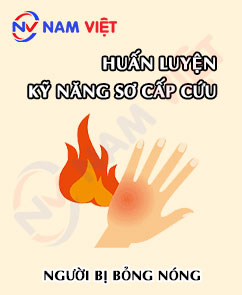
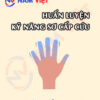
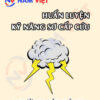

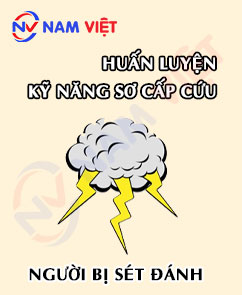
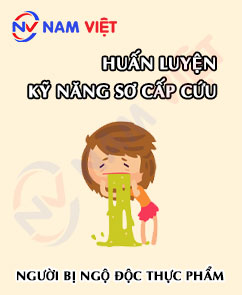
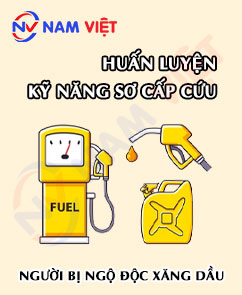


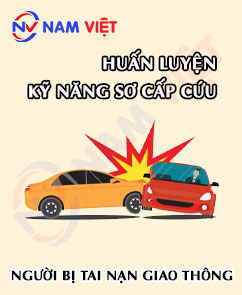
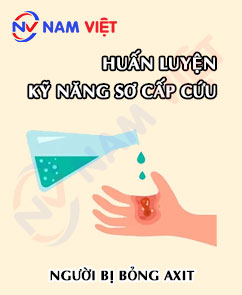
phanminhhang341
Very good and professional first aid training unit